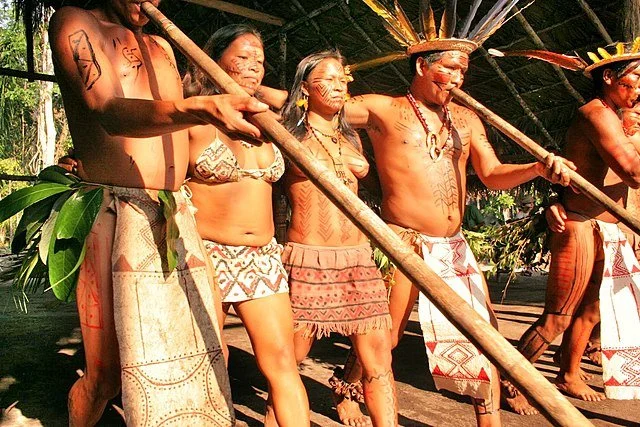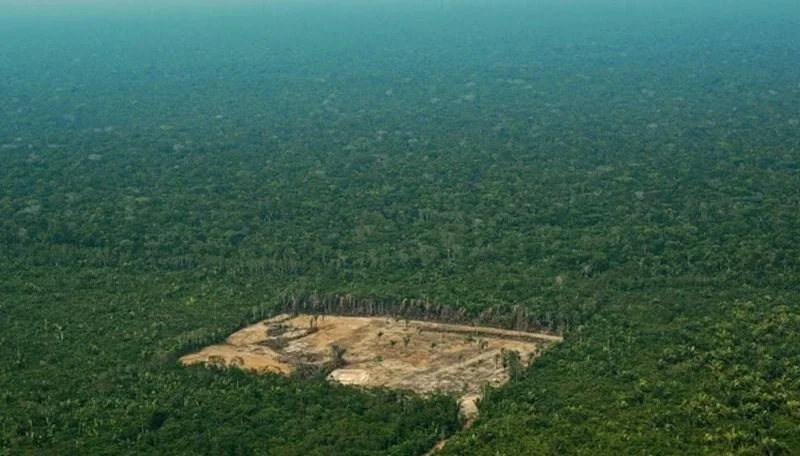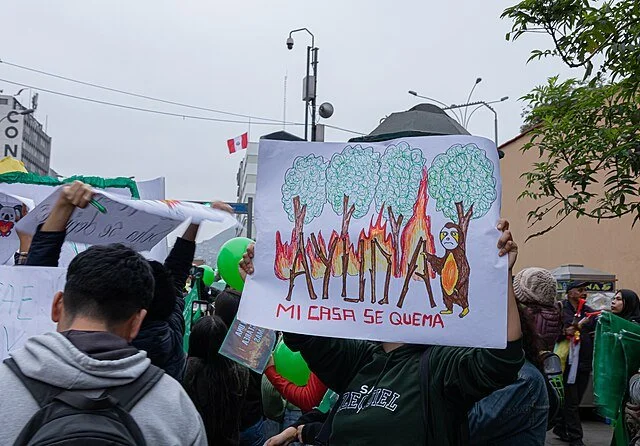Gangs in the Amazon Rainforest are increasingly finding that money does grow on trees and the local flora, fauna and Indigenous groups are paying the price.
An aerial shot of the deforestation caused by illegal mining in the Amazon Rainforest. Planet Labs, Inc. CC BY 4.0.
Covering 6.7 million square kilometers of South America, the Amazon Rainforest has long been heralded as one of the world’s most beautiful natural wonders. But recently, as gang activity, illegal gold mining and deforestation continue to rise, this natural beauty is under threat.
Although concentrated mostly in Brazil, the Amazon spans nine different countries, including Peru, Colombia, and Ecuador. The world’s largest rainforest, the region contains 10% of Earth’s known species, making it a hotspot for wildlife and biodiversity. Scientific American notes that the Amazon is also a beneficial carbon sink; absorbing a significant amount of heat-trapping greenhouse gases in the atmosphere, the rainforest helps mitigate the effects of climate change. Further, the Amazon is home to nearly 2.7 million Indigenous Amazonians, according to the World Wildlife Fund (WWF). Among almost 400 Indigenous ethnic groups, the WWF reports that 60 live in voluntary isolation in order to protect their land and ways of life from outside influences.
Tukanos, an Indigenous Amazonian group. James Martins. CC BY 3.0.
However, as the Council on Foreign Relations (CFR) states, since “the 1960s, when government incentives to clear land for production coincided with more effective tools such as chainsaws and bulldozers,” the Amazon has undergone alarming rates of deforestation. Especially under former Brazilian President Jair Bolsonaro, the emphasis on profits at the expense of environmental and/or Indigenous protections grew abundantly clear as new mining and cattle ranching initiatives took hold. “Deforestation hit a 15-year high during his [2019-2022] term,” the Associated Press reported. As President Bolsonaro “weakened environmental agencies” and “prioritized agribusiness expansion,” he left the rainforest vulnerable to outside exploitation.
In their September 2024 report “Gold, Gangs, and Governance,” Amazon Watch “highlights the increasing influence of organized crime” in the Amazon rainforest. Indeed, the Brazilian Forum on Public Safety affirmed that as of December 2024, “gangs were present in 260 of 772 municipalities in the region, compared with 178 in 2023.” The presence of criminal organizations like Familia do Norte (FDN) and First Capital Command (PCC) has escalated crime and deforestation to the point where homicides have increased by 574% and deforestation by 300%. According to Amazon Watch, both of these rates far exceed the Latin American average. Amazon Watch specifically points to illegal gold mining as a driver of much of this instability. “Due to institutional weakness” and the minerals’ “lack of traceability,” illegal gold is a highly lucrative commodity, bringing in between $800 million and $1 billion in exports for “over 500 shell companies” in 2022. Many gangs feel incentivized to then “reinvest [their] profits from drug trafficking into this activity,” the report found. Although drugs have indeed made the Amazon a violent “smuggling domain,” as The New York Times confirms, illegal mining activities are also responsible for transforming many rainforest cities into zones of conflict by escalating “territorial control disputes” and “strengthening the criminal groups that control mining enclaves.”
Deforestation in the Amazon. Free Malaysia Today. CC BY 4.0.
These cycles of violence have detrimental impacts that reach far beyond the gangs they involve. Amazon Watch found that from 2015 to 2021, “7,495 hectares of rainforest were lost [...] due to illegal mining.” Per Reuters, this damage puts more than 10,000 species of plants and animals at high risk of extinction. This increased deforestation also threatens the rainforest’s aforementioned status as a carbon sink: “Scientists say parts of the forest now emit more carbon dioxide than they can absorb,” the CFR reports. Rather than mitigating the effects of global warming, then, the Amazon could now exacerbate them. Sarah Brown of Mongabay estimates that deforestation will ultimately generate economic losses “seven times higher than the economic gain” of commodities produced through deforestation. Therefore, Brown argues, “deforestation for commodity growth is less valuable than rainforest preservation.”
Economics aside, the human costs of illegal mining are even higher, and they’re already rearing their head. Of the 1,519 instances of illegal mining reported between 2019 and 2024, Amazon Watch found that 46.7% occurred on Indigenous lands, disproportionately affecting the health of Indigenous Amazonians through the contamination of “rivers with heavy metals such as copper, iron, lead, and mercury.” Further, as governments try to combat these illegal activities with increased militarization, they have only provoked “increased violence in Indigenous communities” in the process. As their Amazon Watch affirms, between poisoning resources and outright death threats, gangs in the Amazon and the surrounding governments are “eroding [Indigenous] identity and threatening their cultural and physical survival.” Illegal mining in the Amazon has become a deadly enterprise on multiple fronts.
An environmentalist protest sign that reads “My house is burning” in Spanish. Candy Sotomayor. CC BY 4.0
To get involved, people can support Amazon Watch and their calls for greater institutional strengthening and increased awareness from the global community. The organization also notes that a societal cutback on beef and dairy consumption would help curb the strain of cattle ranching. Nonprofits including the WWF and the Amazon Emergency Fund also work to support sustainability projects and uplift Indigenous communities. From an administrative standpoint, some steps are being made toward these ends: deforestation in 2024 dropped by nearly 31% compared to 2023, and some international governments like the Biden administration pledged funds to support conservation efforts. But until there are strong, long-lasting initiatives that prioritize environmental and Indigenous protections, activists continue to urge the global community to continue raising awareness and applying public pressure on local governments. As Indigenous activist Allessandra Korap told the Associated Press, that “is our top priority, along with the expulsion of illegal miners.”
Bella Liu
Bella is a student at UC Berkeley studying English, Media Studies and Journalism. When she’s not writing or working through the books on her nightstand, you can find her painting her nails red, taking digicam photos with her friends or yelling at the TV to make the Dodgers play better.





